Human Resource Management Report
VerifiedAdded on 2019/12/03
|19
|6285
|163
Report
AI Summary
This report is a comprehensive case study of Human Resource Management (HRM) practices at Hilton Hotels in the UK. It examines various aspects of HRM, including the differences between personnel management and HRM, the roles and responsibilities of line managers, and the impact of legal and regulatory frameworks. The report delves into human resource planning, outlining the stages involved and analyzing the reasons for its importance in meeting organizational goals and adapting to change. A comparison of the recruitment and selection processes at Hilton and McDonald's is presented, along with an evaluation of their effectiveness. The report also explores the link between motivational theories (Maslow's hierarchy of needs and Herzberg's two-factor theory) and reward systems, assessing the effectiveness of these systems in different contexts. Finally, it details methods used to monitor employee performance and identifies reasons for employment cessation, including the legal and regulatory implications of such arrangements. The report concludes by summarizing the key findings and their implications for effective HRM practices.
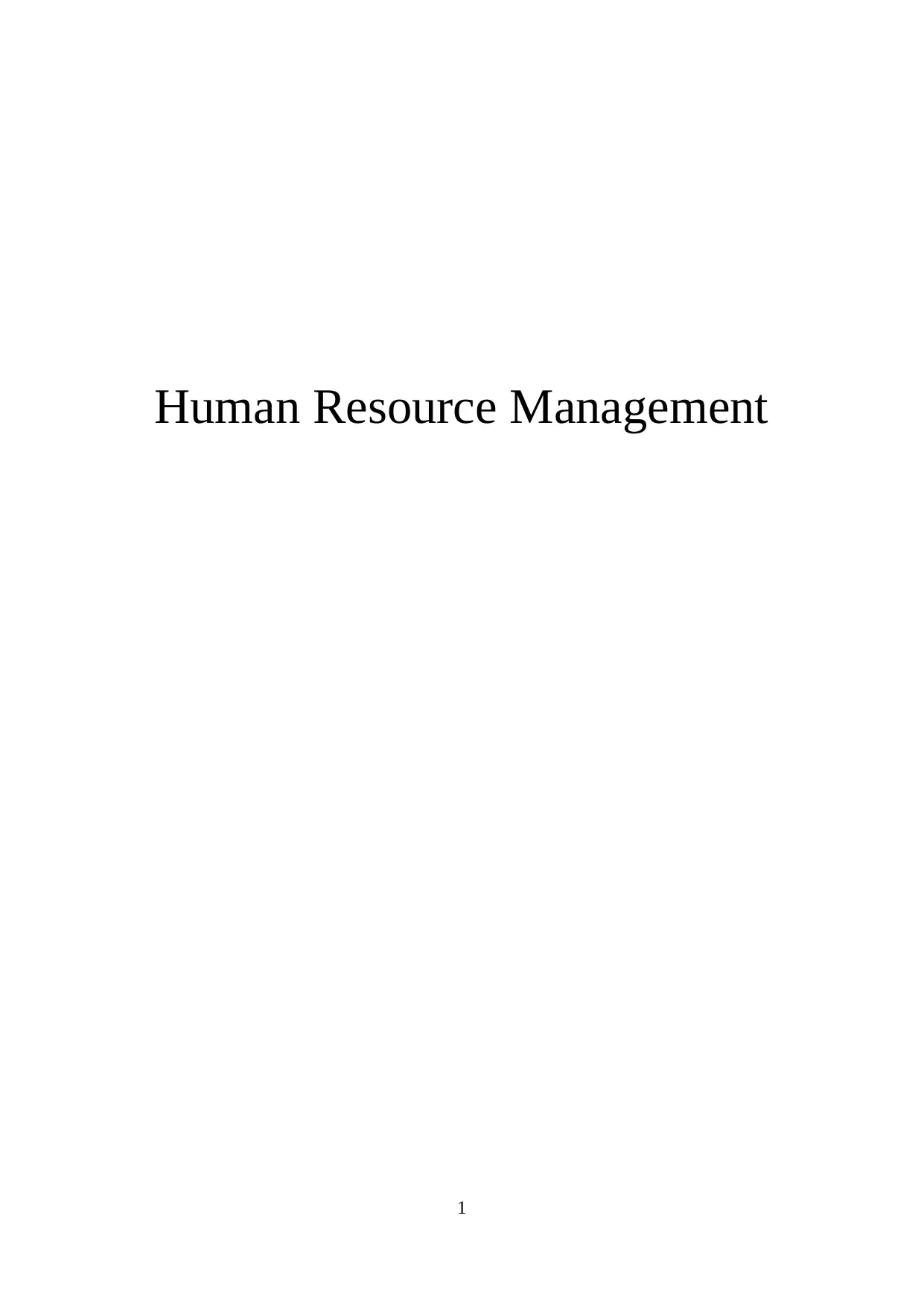
Human Resource Management
1
1
Paraphrase This Document
Need a fresh take? Get an instant paraphrase of this document with our AI Paraphraser
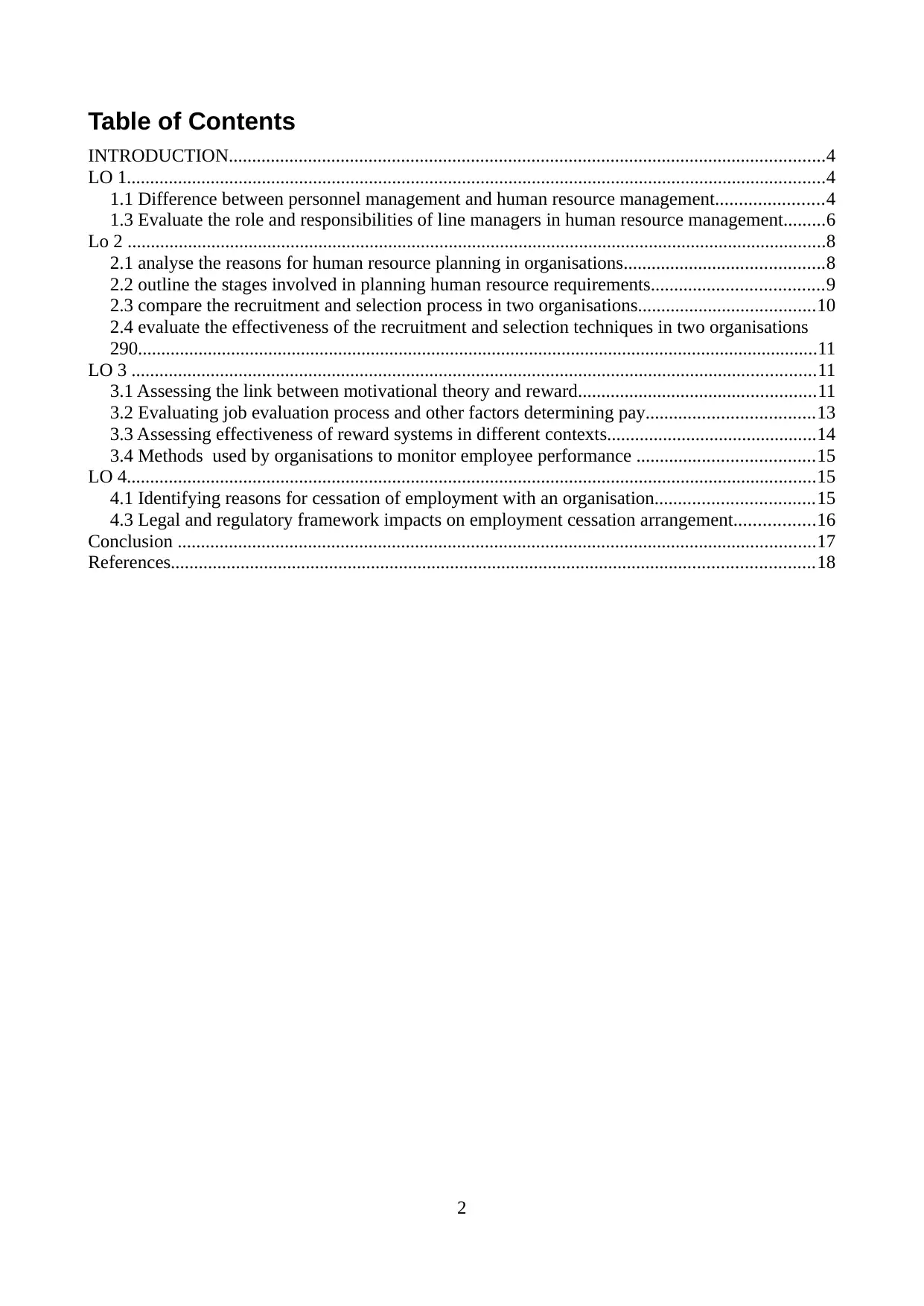
Table of Contents
INTRODUCTION................................................................................................................................4
LO 1......................................................................................................................................................4
1.1 Difference between personnel management and human resource management.......................4
1.3 Evaluate the role and responsibilities of line managers in human resource management.........6
Lo 2 ......................................................................................................................................................8
2.1 analyse the reasons for human resource planning in organisations...........................................8
2.2 outline the stages involved in planning human resource requirements.....................................9
2.3 compare the recruitment and selection process in two organisations......................................10
2.4 evaluate the effectiveness of the recruitment and selection techniques in two organisations
290..................................................................................................................................................11
LO 3 ...................................................................................................................................................11
3.1 Assessing the link between motivational theory and reward...................................................11
3.2 Evaluating job evaluation process and other factors determining pay....................................13
3.3 Assessing effectiveness of reward systems in different contexts.............................................14
3.4 Methods used by organisations to monitor employee performance ......................................15
LO 4....................................................................................................................................................15
4.1 Identifying reasons for cessation of employment with an organisation..................................15
4.3 Legal and regulatory framework impacts on employment cessation arrangement.................16
Conclusion .........................................................................................................................................17
References..........................................................................................................................................18
2
INTRODUCTION................................................................................................................................4
LO 1......................................................................................................................................................4
1.1 Difference between personnel management and human resource management.......................4
1.3 Evaluate the role and responsibilities of line managers in human resource management.........6
Lo 2 ......................................................................................................................................................8
2.1 analyse the reasons for human resource planning in organisations...........................................8
2.2 outline the stages involved in planning human resource requirements.....................................9
2.3 compare the recruitment and selection process in two organisations......................................10
2.4 evaluate the effectiveness of the recruitment and selection techniques in two organisations
290..................................................................................................................................................11
LO 3 ...................................................................................................................................................11
3.1 Assessing the link between motivational theory and reward...................................................11
3.2 Evaluating job evaluation process and other factors determining pay....................................13
3.3 Assessing effectiveness of reward systems in different contexts.............................................14
3.4 Methods used by organisations to monitor employee performance ......................................15
LO 4....................................................................................................................................................15
4.1 Identifying reasons for cessation of employment with an organisation..................................15
4.3 Legal and regulatory framework impacts on employment cessation arrangement.................16
Conclusion .........................................................................................................................................17
References..........................................................................................................................................18
2
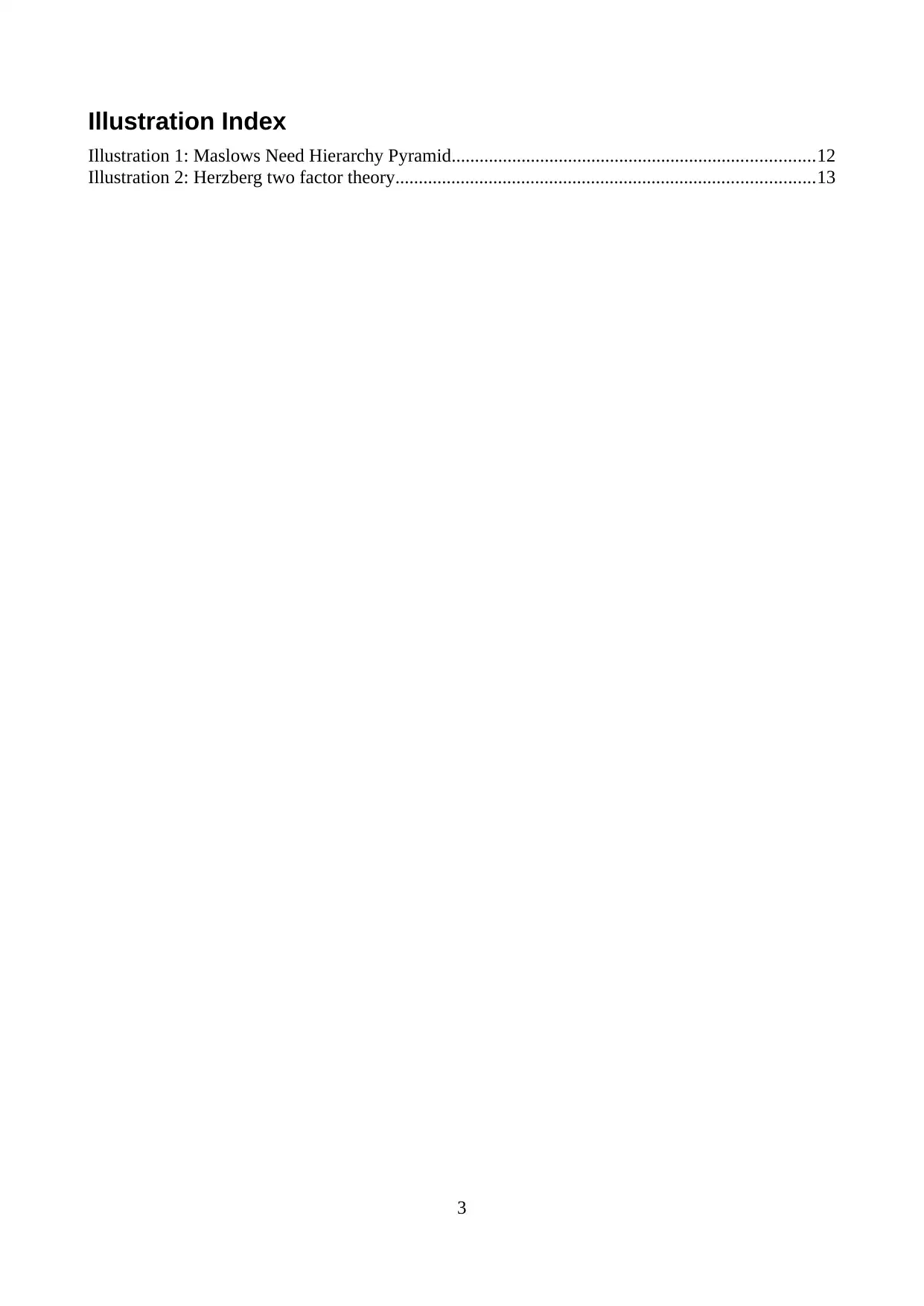
Illustration Index
Illustration 1: Maslows Need Hierarchy Pyramid..............................................................................12
Illustration 2: Herzberg two factor theory..........................................................................................13
3
Illustration 1: Maslows Need Hierarchy Pyramid..............................................................................12
Illustration 2: Herzberg two factor theory..........................................................................................13
3
⊘ This is a preview!⊘
Do you want full access?
Subscribe today to unlock all pages.

Trusted by 1+ million students worldwide
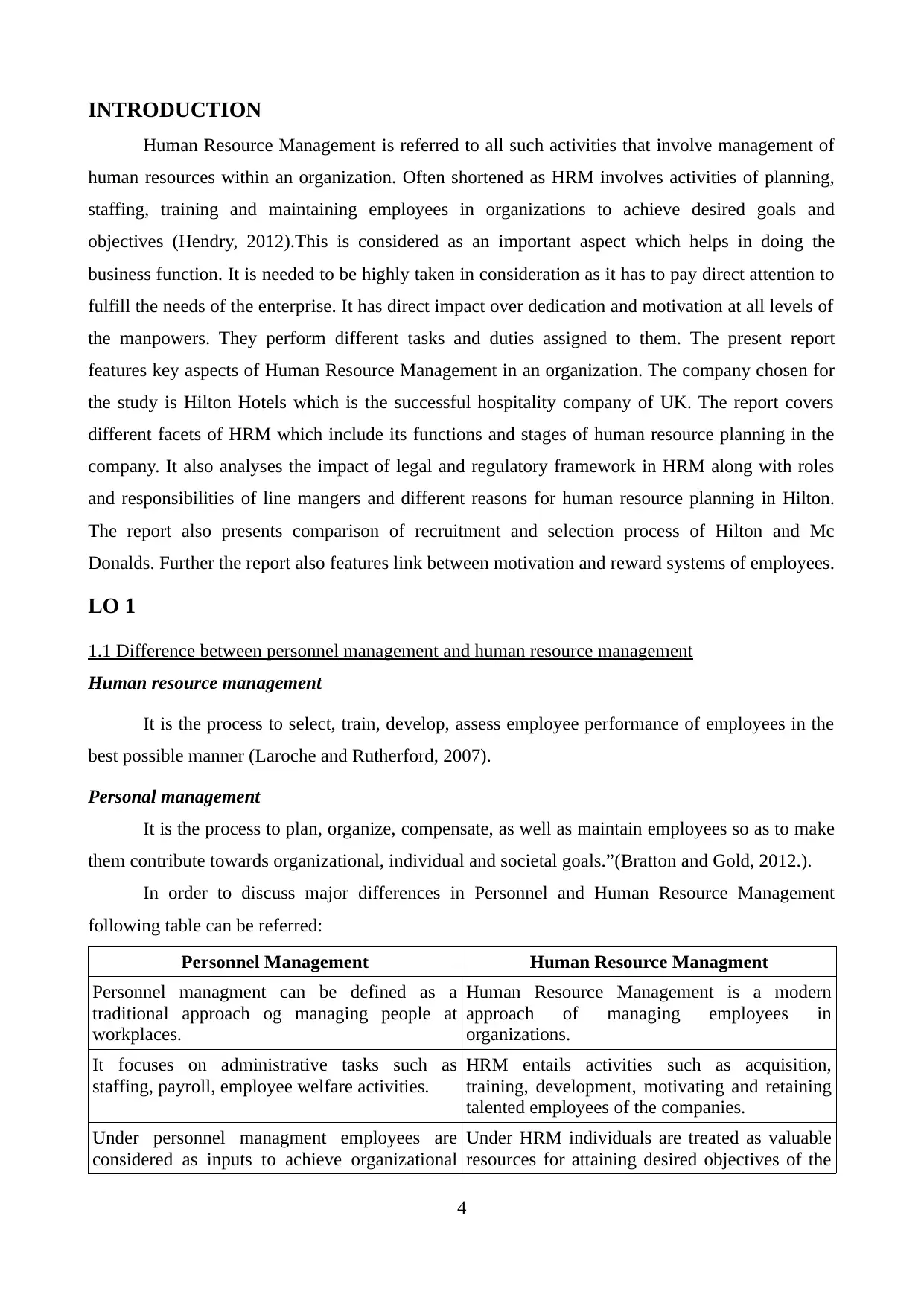
INTRODUCTION
Human Resource Management is referred to all such activities that involve management of
human resources within an organization. Often shortened as HRM involves activities of planning,
staffing, training and maintaining employees in organizations to achieve desired goals and
objectives (Hendry, 2012).This is considered as an important aspect which helps in doing the
business function. It is needed to be highly taken in consideration as it has to pay direct attention to
fulfill the needs of the enterprise. It has direct impact over dedication and motivation at all levels of
the manpowers. They perform different tasks and duties assigned to them. The present report
features key aspects of Human Resource Management in an organization. The company chosen for
the study is Hilton Hotels which is the successful hospitality company of UK. The report covers
different facets of HRM which include its functions and stages of human resource planning in the
company. It also analyses the impact of legal and regulatory framework in HRM along with roles
and responsibilities of line mangers and different reasons for human resource planning in Hilton.
The report also presents comparison of recruitment and selection process of Hilton and Mc
Donalds. Further the report also features link between motivation and reward systems of employees.
LO 1
1.1 Difference between personnel management and human resource management
Human resource management
It is the process to select, train, develop, assess employee performance of employees in the
best possible manner (Laroche and Rutherford, 2007).
Personal management
It is the process to plan, organize, compensate, as well as maintain employees so as to make
them contribute towards organizational, individual and societal goals.”(Bratton and Gold, 2012.).
In order to discuss major differences in Personnel and Human Resource Management
following table can be referred:
Personnel Management Human Resource Managment
Personnel managment can be defined as a
traditional approach og managing people at
workplaces.
Human Resource Management is a modern
approach of managing employees in
organizations.
It focuses on administrative tasks such as
staffing, payroll, employee welfare activities.
HRM entails activities such as acquisition,
training, development, motivating and retaining
talented employees of the companies.
Under personnel managment employees are
considered as inputs to achieve organizational
Under HRM individuals are treated as valuable
resources for attaining desired objectives of the
4
Human Resource Management is referred to all such activities that involve management of
human resources within an organization. Often shortened as HRM involves activities of planning,
staffing, training and maintaining employees in organizations to achieve desired goals and
objectives (Hendry, 2012).This is considered as an important aspect which helps in doing the
business function. It is needed to be highly taken in consideration as it has to pay direct attention to
fulfill the needs of the enterprise. It has direct impact over dedication and motivation at all levels of
the manpowers. They perform different tasks and duties assigned to them. The present report
features key aspects of Human Resource Management in an organization. The company chosen for
the study is Hilton Hotels which is the successful hospitality company of UK. The report covers
different facets of HRM which include its functions and stages of human resource planning in the
company. It also analyses the impact of legal and regulatory framework in HRM along with roles
and responsibilities of line mangers and different reasons for human resource planning in Hilton.
The report also presents comparison of recruitment and selection process of Hilton and Mc
Donalds. Further the report also features link between motivation and reward systems of employees.
LO 1
1.1 Difference between personnel management and human resource management
Human resource management
It is the process to select, train, develop, assess employee performance of employees in the
best possible manner (Laroche and Rutherford, 2007).
Personal management
It is the process to plan, organize, compensate, as well as maintain employees so as to make
them contribute towards organizational, individual and societal goals.”(Bratton and Gold, 2012.).
In order to discuss major differences in Personnel and Human Resource Management
following table can be referred:
Personnel Management Human Resource Managment
Personnel managment can be defined as a
traditional approach og managing people at
workplaces.
Human Resource Management is a modern
approach of managing employees in
organizations.
It focuses on administrative tasks such as
staffing, payroll, employee welfare activities.
HRM entails activities such as acquisition,
training, development, motivating and retaining
talented employees of the companies.
Under personnel managment employees are
considered as inputs to achieve organizational
Under HRM individuals are treated as valuable
resources for attaining desired objectives of the
4
Paraphrase This Document
Need a fresh take? Get an instant paraphrase of this document with our AI Paraphraser
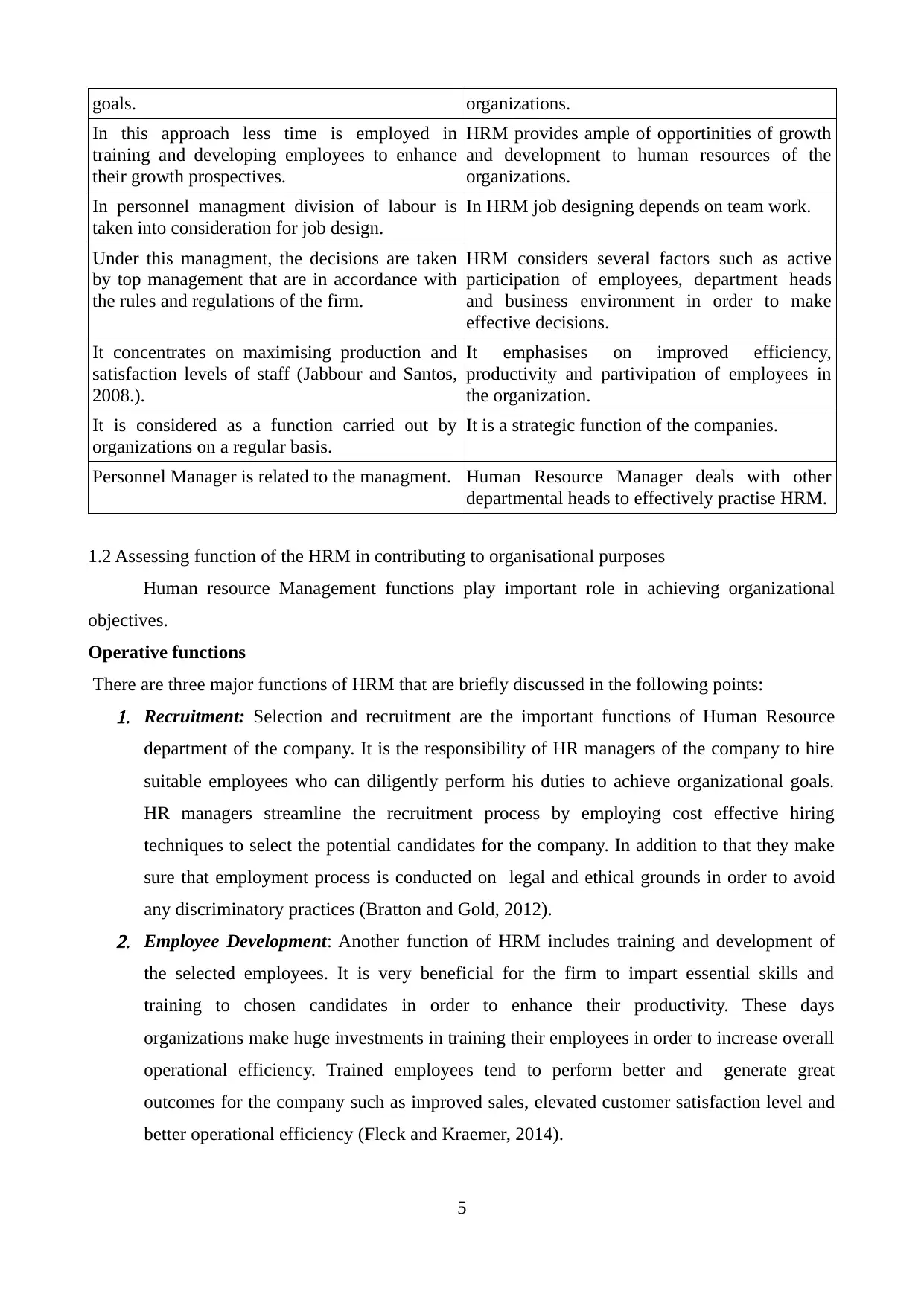
goals. organizations.
In this approach less time is employed in
training and developing employees to enhance
their growth prospectives.
HRM provides ample of opportinities of growth
and development to human resources of the
organizations.
In personnel managment division of labour is
taken into consideration for job design.
In HRM job designing depends on team work.
Under this managment, the decisions are taken
by top management that are in accordance with
the rules and regulations of the firm.
HRM considers several factors such as active
participation of employees, department heads
and business environment in order to make
effective decisions.
It concentrates on maximising production and
satisfaction levels of staff (Jabbour and Santos,
2008.).
It emphasises on improved efficiency,
productivity and partivipation of employees in
the organization.
It is considered as a function carried out by
organizations on a regular basis.
It is a strategic function of the companies.
Personnel Manager is related to the managment. Human Resource Manager deals with other
departmental heads to effectively practise HRM.
1.2 Assessing function of the HRM in contributing to organisational purposes
Human resource Management functions play important role in achieving organizational
objectives.
Operative functions
There are three major functions of HRM that are briefly discussed in the following points:1. Recruitment: Selection and recruitment are the important functions of Human Resource
department of the company. It is the responsibility of HR managers of the company to hire
suitable employees who can diligently perform his duties to achieve organizational goals.
HR managers streamline the recruitment process by employing cost effective hiring
techniques to select the potential candidates for the company. In addition to that they make
sure that employment process is conducted on legal and ethical grounds in order to avoid
any discriminatory practices (Bratton and Gold, 2012).2. Employee Development: Another function of HRM includes training and development of
the selected employees. It is very beneficial for the firm to impart essential skills and
training to chosen candidates in order to enhance their productivity. These days
organizations make huge investments in training their employees in order to increase overall
operational efficiency. Trained employees tend to perform better and generate great
outcomes for the company such as improved sales, elevated customer satisfaction level and
better operational efficiency (Fleck and Kraemer, 2014).
5
In this approach less time is employed in
training and developing employees to enhance
their growth prospectives.
HRM provides ample of opportinities of growth
and development to human resources of the
organizations.
In personnel managment division of labour is
taken into consideration for job design.
In HRM job designing depends on team work.
Under this managment, the decisions are taken
by top management that are in accordance with
the rules and regulations of the firm.
HRM considers several factors such as active
participation of employees, department heads
and business environment in order to make
effective decisions.
It concentrates on maximising production and
satisfaction levels of staff (Jabbour and Santos,
2008.).
It emphasises on improved efficiency,
productivity and partivipation of employees in
the organization.
It is considered as a function carried out by
organizations on a regular basis.
It is a strategic function of the companies.
Personnel Manager is related to the managment. Human Resource Manager deals with other
departmental heads to effectively practise HRM.
1.2 Assessing function of the HRM in contributing to organisational purposes
Human resource Management functions play important role in achieving organizational
objectives.
Operative functions
There are three major functions of HRM that are briefly discussed in the following points:1. Recruitment: Selection and recruitment are the important functions of Human Resource
department of the company. It is the responsibility of HR managers of the company to hire
suitable employees who can diligently perform his duties to achieve organizational goals.
HR managers streamline the recruitment process by employing cost effective hiring
techniques to select the potential candidates for the company. In addition to that they make
sure that employment process is conducted on legal and ethical grounds in order to avoid
any discriminatory practices (Bratton and Gold, 2012).2. Employee Development: Another function of HRM includes training and development of
the selected employees. It is very beneficial for the firm to impart essential skills and
training to chosen candidates in order to enhance their productivity. These days
organizations make huge investments in training their employees in order to increase overall
operational efficiency. Trained employees tend to perform better and generate great
outcomes for the company such as improved sales, elevated customer satisfaction level and
better operational efficiency (Fleck and Kraemer, 2014).
5
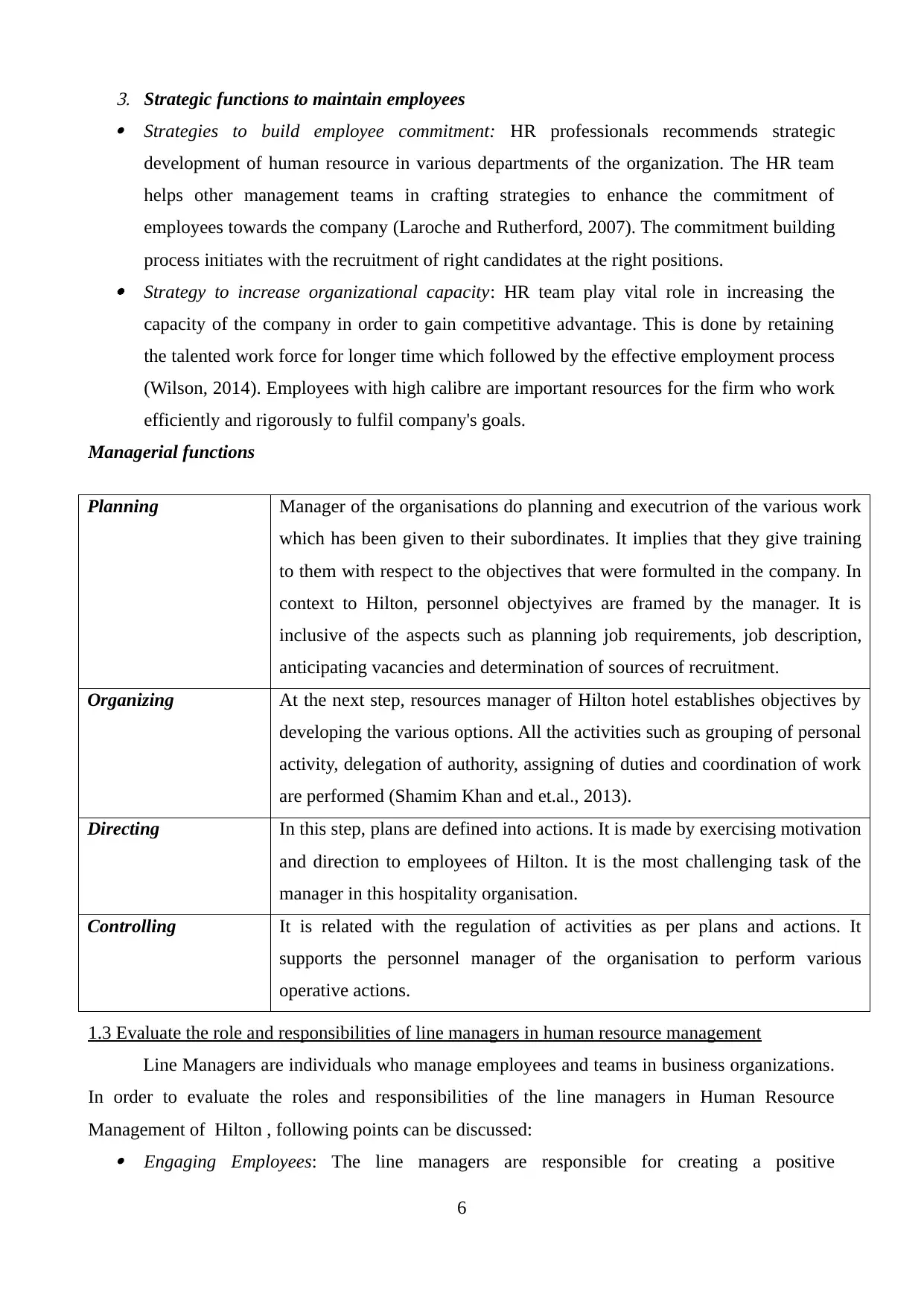
3. Strategic functions to maintain employees Strategies to build employee commitment: HR professionals recommends strategic
development of human resource in various departments of the organization. The HR team
helps other management teams in crafting strategies to enhance the commitment of
employees towards the company (Laroche and Rutherford, 2007). The commitment building
process initiates with the recruitment of right candidates at the right positions. Strategy to increase organizational capacity: HR team play vital role in increasing the
capacity of the company in order to gain competitive advantage. This is done by retaining
the talented work force for longer time which followed by the effective employment process
(Wilson, 2014). Employees with high calibre are important resources for the firm who work
efficiently and rigorously to fulfil company's goals.
Managerial functions
Planning Manager of the organisations do planning and executrion of the various work
which has been given to their subordinates. It implies that they give training
to them with respect to the objectives that were formulted in the company. In
context to Hilton, personnel objectyives are framed by the manager. It is
inclusive of the aspects such as planning job requirements, job description,
anticipating vacancies and determination of sources of recruitment.
Organizing At the next step, resources manager of Hilton hotel establishes objectives by
developing the various options. All the activities such as grouping of personal
activity, delegation of authority, assigning of duties and coordination of work
are performed (Shamim Khan and et.al., 2013).
Directing In this step, plans are defined into actions. It is made by exercising motivation
and direction to employees of Hilton. It is the most challenging task of the
manager in this hospitality organisation.
Controlling It is related with the regulation of activities as per plans and actions. It
supports the personnel manager of the organisation to perform various
operative actions.
1.3 Evaluate the role and responsibilities of line managers in human resource management
Line Managers are individuals who manage employees and teams in business organizations.
In order to evaluate the roles and responsibilities of the line managers in Human Resource
Management of Hilton , following points can be discussed: Engaging Employees: The line managers are responsible for creating a positive
6
development of human resource in various departments of the organization. The HR team
helps other management teams in crafting strategies to enhance the commitment of
employees towards the company (Laroche and Rutherford, 2007). The commitment building
process initiates with the recruitment of right candidates at the right positions. Strategy to increase organizational capacity: HR team play vital role in increasing the
capacity of the company in order to gain competitive advantage. This is done by retaining
the talented work force for longer time which followed by the effective employment process
(Wilson, 2014). Employees with high calibre are important resources for the firm who work
efficiently and rigorously to fulfil company's goals.
Managerial functions
Planning Manager of the organisations do planning and executrion of the various work
which has been given to their subordinates. It implies that they give training
to them with respect to the objectives that were formulted in the company. In
context to Hilton, personnel objectyives are framed by the manager. It is
inclusive of the aspects such as planning job requirements, job description,
anticipating vacancies and determination of sources of recruitment.
Organizing At the next step, resources manager of Hilton hotel establishes objectives by
developing the various options. All the activities such as grouping of personal
activity, delegation of authority, assigning of duties and coordination of work
are performed (Shamim Khan and et.al., 2013).
Directing In this step, plans are defined into actions. It is made by exercising motivation
and direction to employees of Hilton. It is the most challenging task of the
manager in this hospitality organisation.
Controlling It is related with the regulation of activities as per plans and actions. It
supports the personnel manager of the organisation to perform various
operative actions.
1.3 Evaluate the role and responsibilities of line managers in human resource management
Line Managers are individuals who manage employees and teams in business organizations.
In order to evaluate the roles and responsibilities of the line managers in Human Resource
Management of Hilton , following points can be discussed: Engaging Employees: The line managers are responsible for creating a positive
6
⊘ This is a preview!⊘
Do you want full access?
Subscribe today to unlock all pages.

Trusted by 1+ million students worldwide
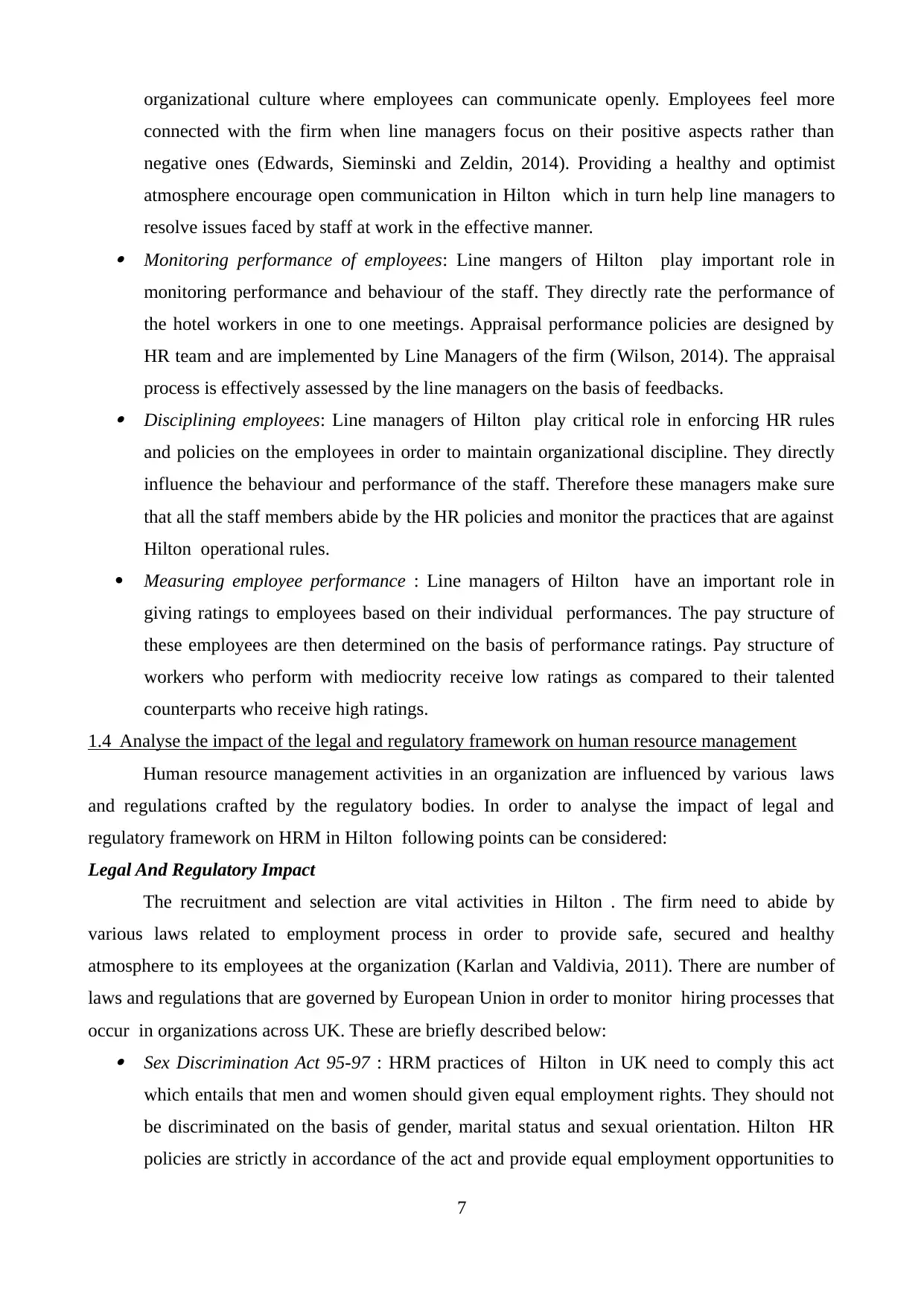
organizational culture where employees can communicate openly. Employees feel more
connected with the firm when line managers focus on their positive aspects rather than
negative ones (Edwards, Sieminski and Zeldin, 2014). Providing a healthy and optimist
atmosphere encourage open communication in Hilton which in turn help line managers to
resolve issues faced by staff at work in the effective manner. Monitoring performance of employees: Line mangers of Hilton play important role in
monitoring performance and behaviour of the staff. They directly rate the performance of
the hotel workers in one to one meetings. Appraisal performance policies are designed by
HR team and are implemented by Line Managers of the firm (Wilson, 2014). The appraisal
process is effectively assessed by the line managers on the basis of feedbacks. Disciplining employees: Line managers of Hilton play critical role in enforcing HR rules
and policies on the employees in order to maintain organizational discipline. They directly
influence the behaviour and performance of the staff. Therefore these managers make sure
that all the staff members abide by the HR policies and monitor the practices that are against
Hilton operational rules.
Measuring employee performance : Line managers of Hilton have an important role in
giving ratings to employees based on their individual performances. The pay structure of
these employees are then determined on the basis of performance ratings. Pay structure of
workers who perform with mediocrity receive low ratings as compared to their talented
counterparts who receive high ratings.
1.4 Analyse the impact of the legal and regulatory framework on human resource management
Human resource management activities in an organization are influenced by various laws
and regulations crafted by the regulatory bodies. In order to analyse the impact of legal and
regulatory framework on HRM in Hilton following points can be considered:
Legal And Regulatory Impact
The recruitment and selection are vital activities in Hilton . The firm need to abide by
various laws related to employment process in order to provide safe, secured and healthy
atmosphere to its employees at the organization (Karlan and Valdivia, 2011). There are number of
laws and regulations that are governed by European Union in order to monitor hiring processes that
occur in organizations across UK. These are briefly described below: Sex Discrimination Act 95-97 : HRM practices of Hilton in UK need to comply this act
which entails that men and women should given equal employment rights. They should not
be discriminated on the basis of gender, marital status and sexual orientation. Hilton HR
policies are strictly in accordance of the act and provide equal employment opportunities to
7
connected with the firm when line managers focus on their positive aspects rather than
negative ones (Edwards, Sieminski and Zeldin, 2014). Providing a healthy and optimist
atmosphere encourage open communication in Hilton which in turn help line managers to
resolve issues faced by staff at work in the effective manner. Monitoring performance of employees: Line mangers of Hilton play important role in
monitoring performance and behaviour of the staff. They directly rate the performance of
the hotel workers in one to one meetings. Appraisal performance policies are designed by
HR team and are implemented by Line Managers of the firm (Wilson, 2014). The appraisal
process is effectively assessed by the line managers on the basis of feedbacks. Disciplining employees: Line managers of Hilton play critical role in enforcing HR rules
and policies on the employees in order to maintain organizational discipline. They directly
influence the behaviour and performance of the staff. Therefore these managers make sure
that all the staff members abide by the HR policies and monitor the practices that are against
Hilton operational rules.
Measuring employee performance : Line managers of Hilton have an important role in
giving ratings to employees based on their individual performances. The pay structure of
these employees are then determined on the basis of performance ratings. Pay structure of
workers who perform with mediocrity receive low ratings as compared to their talented
counterparts who receive high ratings.
1.4 Analyse the impact of the legal and regulatory framework on human resource management
Human resource management activities in an organization are influenced by various laws
and regulations crafted by the regulatory bodies. In order to analyse the impact of legal and
regulatory framework on HRM in Hilton following points can be considered:
Legal And Regulatory Impact
The recruitment and selection are vital activities in Hilton . The firm need to abide by
various laws related to employment process in order to provide safe, secured and healthy
atmosphere to its employees at the organization (Karlan and Valdivia, 2011). There are number of
laws and regulations that are governed by European Union in order to monitor hiring processes that
occur in organizations across UK. These are briefly described below: Sex Discrimination Act 95-97 : HRM practices of Hilton in UK need to comply this act
which entails that men and women should given equal employment rights. They should not
be discriminated on the basis of gender, marital status and sexual orientation. Hilton HR
policies are strictly in accordance of the act and provide equal employment opportunities to
7
Paraphrase This Document
Need a fresh take? Get an instant paraphrase of this document with our AI Paraphraser
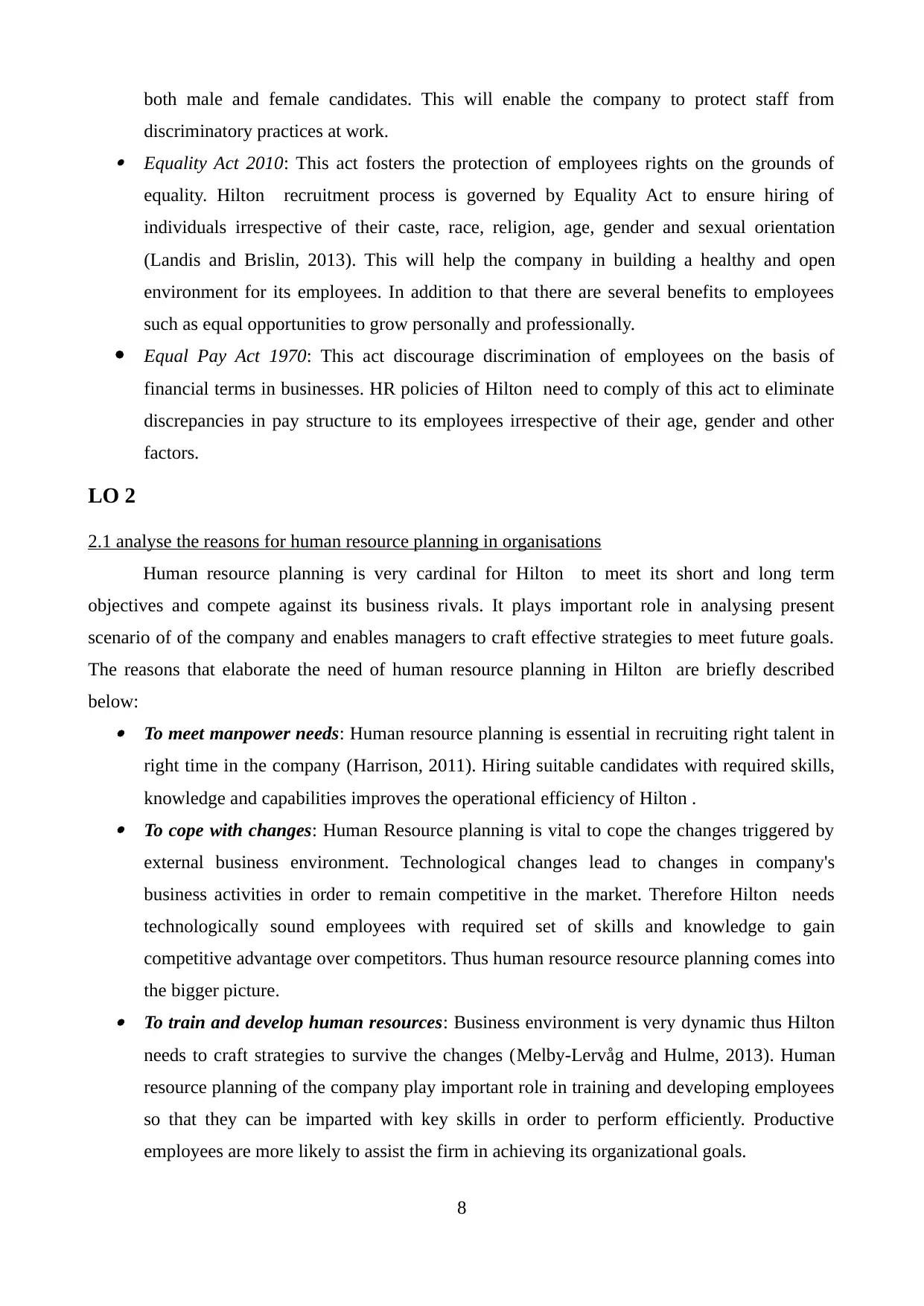
both male and female candidates. This will enable the company to protect staff from
discriminatory practices at work. Equality Act 2010: This act fosters the protection of employees rights on the grounds of
equality. Hilton recruitment process is governed by Equality Act to ensure hiring of
individuals irrespective of their caste, race, religion, age, gender and sexual orientation
(Landis and Brislin, 2013). This will help the company in building a healthy and open
environment for its employees. In addition to that there are several benefits to employees
such as equal opportunities to grow personally and professionally.
Equal Pay Act 1970: This act discourage discrimination of employees on the basis of
financial terms in businesses. HR policies of Hilton need to comply of this act to eliminate
discrepancies in pay structure to its employees irrespective of their age, gender and other
factors.
LO 2
2.1 analyse the reasons for human resource planning in organisations
Human resource planning is very cardinal for Hilton to meet its short and long term
objectives and compete against its business rivals. It plays important role in analysing present
scenario of of the company and enables managers to craft effective strategies to meet future goals.
The reasons that elaborate the need of human resource planning in Hilton are briefly described
below: To meet manpower needs: Human resource planning is essential in recruiting right talent in
right time in the company (Harrison, 2011). Hiring suitable candidates with required skills,
knowledge and capabilities improves the operational efficiency of Hilton . To cope with changes: Human Resource planning is vital to cope the changes triggered by
external business environment. Technological changes lead to changes in company's
business activities in order to remain competitive in the market. Therefore Hilton needs
technologically sound employees with required set of skills and knowledge to gain
competitive advantage over competitors. Thus human resource resource planning comes into
the bigger picture. To train and develop human resources: Business environment is very dynamic thus Hilton
needs to craft strategies to survive the changes (Melby-Lervåg and Hulme, 2013). Human
resource planning of the company play important role in training and developing employees
so that they can be imparted with key skills in order to perform efficiently. Productive
employees are more likely to assist the firm in achieving its organizational goals.
8
discriminatory practices at work. Equality Act 2010: This act fosters the protection of employees rights on the grounds of
equality. Hilton recruitment process is governed by Equality Act to ensure hiring of
individuals irrespective of their caste, race, religion, age, gender and sexual orientation
(Landis and Brislin, 2013). This will help the company in building a healthy and open
environment for its employees. In addition to that there are several benefits to employees
such as equal opportunities to grow personally and professionally.
Equal Pay Act 1970: This act discourage discrimination of employees on the basis of
financial terms in businesses. HR policies of Hilton need to comply of this act to eliminate
discrepancies in pay structure to its employees irrespective of their age, gender and other
factors.
LO 2
2.1 analyse the reasons for human resource planning in organisations
Human resource planning is very cardinal for Hilton to meet its short and long term
objectives and compete against its business rivals. It plays important role in analysing present
scenario of of the company and enables managers to craft effective strategies to meet future goals.
The reasons that elaborate the need of human resource planning in Hilton are briefly described
below: To meet manpower needs: Human resource planning is essential in recruiting right talent in
right time in the company (Harrison, 2011). Hiring suitable candidates with required skills,
knowledge and capabilities improves the operational efficiency of Hilton . To cope with changes: Human Resource planning is vital to cope the changes triggered by
external business environment. Technological changes lead to changes in company's
business activities in order to remain competitive in the market. Therefore Hilton needs
technologically sound employees with required set of skills and knowledge to gain
competitive advantage over competitors. Thus human resource resource planning comes into
the bigger picture. To train and develop human resources: Business environment is very dynamic thus Hilton
needs to craft strategies to survive the changes (Melby-Lervåg and Hulme, 2013). Human
resource planning of the company play important role in training and developing employees
so that they can be imparted with key skills in order to perform efficiently. Productive
employees are more likely to assist the firm in achieving its organizational goals.
8
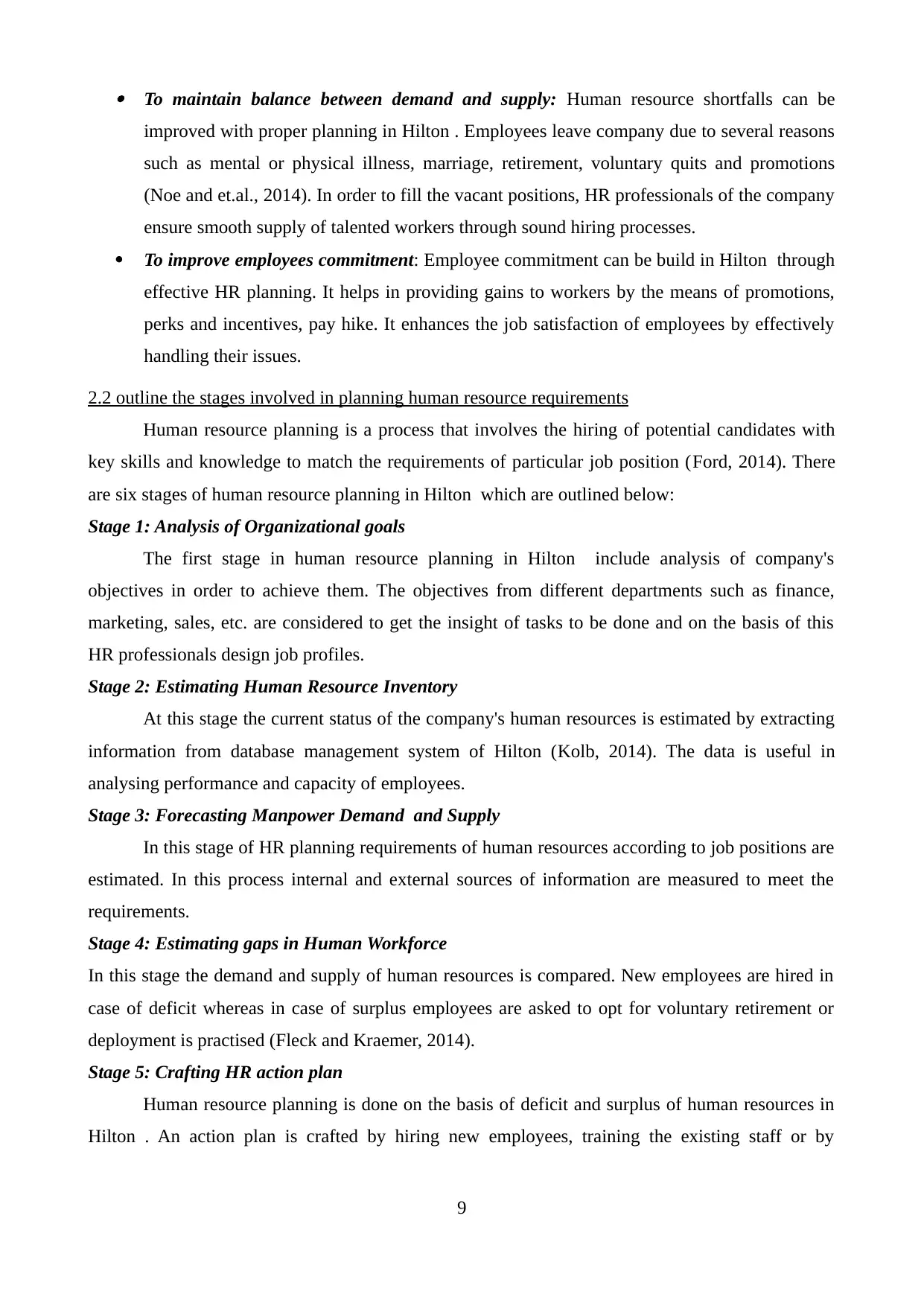
To maintain balance between demand and supply: Human resource shortfalls can be
improved with proper planning in Hilton . Employees leave company due to several reasons
such as mental or physical illness, marriage, retirement, voluntary quits and promotions
(Noe and et.al., 2014). In order to fill the vacant positions, HR professionals of the company
ensure smooth supply of talented workers through sound hiring processes.
To improve employees commitment: Employee commitment can be build in Hilton through
effective HR planning. It helps in providing gains to workers by the means of promotions,
perks and incentives, pay hike. It enhances the job satisfaction of employees by effectively
handling their issues.
2.2 outline the stages involved in planning human resource requirements
Human resource planning is a process that involves the hiring of potential candidates with
key skills and knowledge to match the requirements of particular job position (Ford, 2014). There
are six stages of human resource planning in Hilton which are outlined below:
Stage 1: Analysis of Organizational goals
The first stage in human resource planning in Hilton include analysis of company's
objectives in order to achieve them. The objectives from different departments such as finance,
marketing, sales, etc. are considered to get the insight of tasks to be done and on the basis of this
HR professionals design job profiles.
Stage 2: Estimating Human Resource Inventory
At this stage the current status of the company's human resources is estimated by extracting
information from database management system of Hilton (Kolb, 2014). The data is useful in
analysing performance and capacity of employees.
Stage 3: Forecasting Manpower Demand and Supply
In this stage of HR planning requirements of human resources according to job positions are
estimated. In this process internal and external sources of information are measured to meet the
requirements.
Stage 4: Estimating gaps in Human Workforce
In this stage the demand and supply of human resources is compared. New employees are hired in
case of deficit whereas in case of surplus employees are asked to opt for voluntary retirement or
deployment is practised (Fleck and Kraemer, 2014).
Stage 5: Crafting HR action plan
Human resource planning is done on the basis of deficit and surplus of human resources in
Hilton . An action plan is crafted by hiring new employees, training the existing staff or by
9
improved with proper planning in Hilton . Employees leave company due to several reasons
such as mental or physical illness, marriage, retirement, voluntary quits and promotions
(Noe and et.al., 2014). In order to fill the vacant positions, HR professionals of the company
ensure smooth supply of talented workers through sound hiring processes.
To improve employees commitment: Employee commitment can be build in Hilton through
effective HR planning. It helps in providing gains to workers by the means of promotions,
perks and incentives, pay hike. It enhances the job satisfaction of employees by effectively
handling their issues.
2.2 outline the stages involved in planning human resource requirements
Human resource planning is a process that involves the hiring of potential candidates with
key skills and knowledge to match the requirements of particular job position (Ford, 2014). There
are six stages of human resource planning in Hilton which are outlined below:
Stage 1: Analysis of Organizational goals
The first stage in human resource planning in Hilton include analysis of company's
objectives in order to achieve them. The objectives from different departments such as finance,
marketing, sales, etc. are considered to get the insight of tasks to be done and on the basis of this
HR professionals design job profiles.
Stage 2: Estimating Human Resource Inventory
At this stage the current status of the company's human resources is estimated by extracting
information from database management system of Hilton (Kolb, 2014). The data is useful in
analysing performance and capacity of employees.
Stage 3: Forecasting Manpower Demand and Supply
In this stage of HR planning requirements of human resources according to job positions are
estimated. In this process internal and external sources of information are measured to meet the
requirements.
Stage 4: Estimating gaps in Human Workforce
In this stage the demand and supply of human resources is compared. New employees are hired in
case of deficit whereas in case of surplus employees are asked to opt for voluntary retirement or
deployment is practised (Fleck and Kraemer, 2014).
Stage 5: Crafting HR action plan
Human resource planning is done on the basis of deficit and surplus of human resources in
Hilton . An action plan is crafted by hiring new employees, training the existing staff or by
9
⊘ This is a preview!⊘
Do you want full access?
Subscribe today to unlock all pages.

Trusted by 1+ million students worldwide
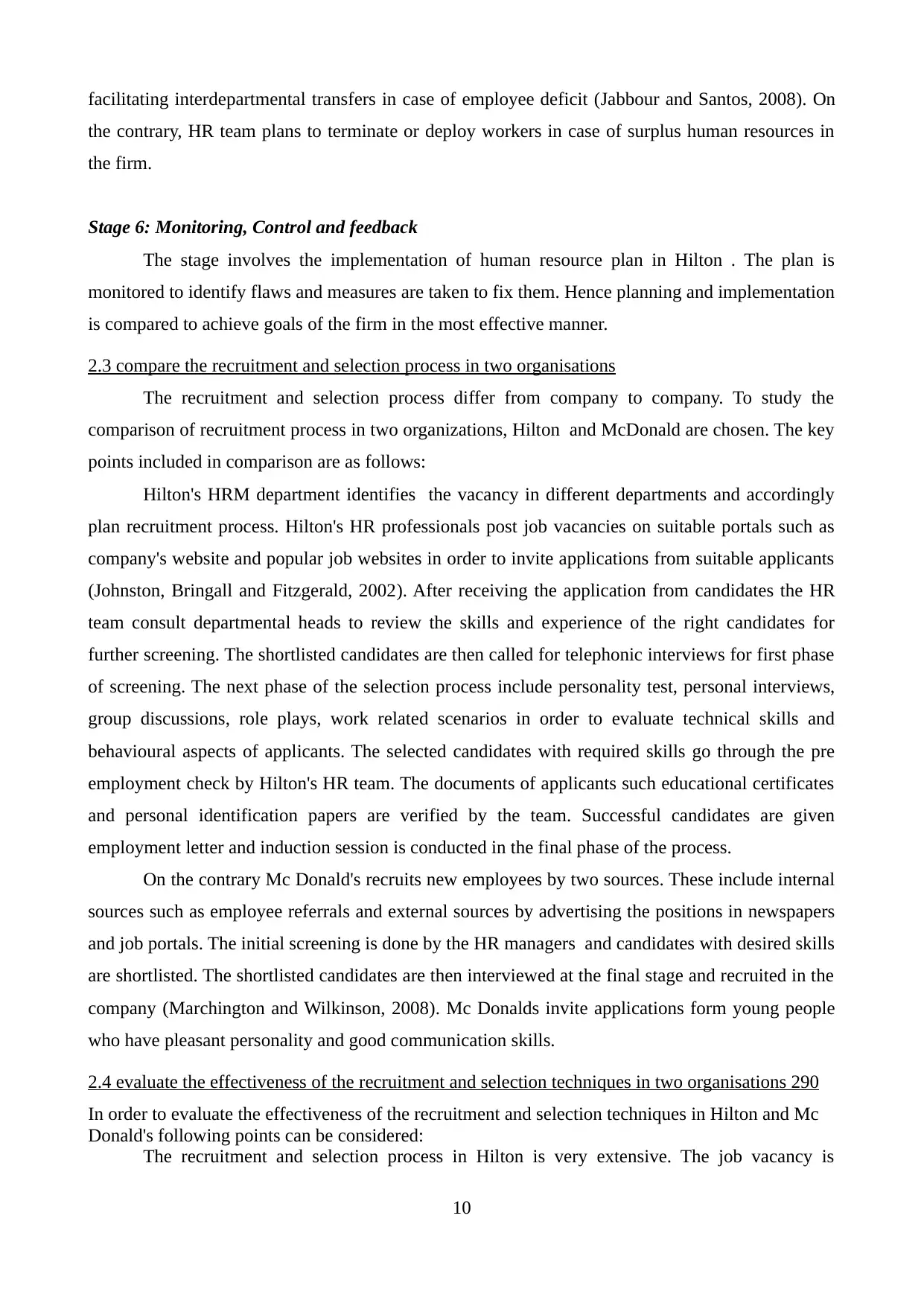
facilitating interdepartmental transfers in case of employee deficit (Jabbour and Santos, 2008). On
the contrary, HR team plans to terminate or deploy workers in case of surplus human resources in
the firm.
Stage 6: Monitoring, Control and feedback
The stage involves the implementation of human resource plan in Hilton . The plan is
monitored to identify flaws and measures are taken to fix them. Hence planning and implementation
is compared to achieve goals of the firm in the most effective manner.
2.3 compare the recruitment and selection process in two organisations
The recruitment and selection process differ from company to company. To study the
comparison of recruitment process in two organizations, Hilton and McDonald are chosen. The key
points included in comparison are as follows:
Hilton's HRM department identifies the vacancy in different departments and accordingly
plan recruitment process. Hilton's HR professionals post job vacancies on suitable portals such as
company's website and popular job websites in order to invite applications from suitable applicants
(Johnston, Bringall and Fitzgerald, 2002). After receiving the application from candidates the HR
team consult departmental heads to review the skills and experience of the right candidates for
further screening. The shortlisted candidates are then called for telephonic interviews for first phase
of screening. The next phase of the selection process include personality test, personal interviews,
group discussions, role plays, work related scenarios in order to evaluate technical skills and
behavioural aspects of applicants. The selected candidates with required skills go through the pre
employment check by Hilton's HR team. The documents of applicants such educational certificates
and personal identification papers are verified by the team. Successful candidates are given
employment letter and induction session is conducted in the final phase of the process.
On the contrary Mc Donald's recruits new employees by two sources. These include internal
sources such as employee referrals and external sources by advertising the positions in newspapers
and job portals. The initial screening is done by the HR managers and candidates with desired skills
are shortlisted. The shortlisted candidates are then interviewed at the final stage and recruited in the
company (Marchington and Wilkinson, 2008). Mc Donalds invite applications form young people
who have pleasant personality and good communication skills.
2.4 evaluate the effectiveness of the recruitment and selection techniques in two organisations 290
In order to evaluate the effectiveness of the recruitment and selection techniques in Hilton and Mc
Donald's following points can be considered:
The recruitment and selection process in Hilton is very extensive. The job vacancy is
10
the contrary, HR team plans to terminate or deploy workers in case of surplus human resources in
the firm.
Stage 6: Monitoring, Control and feedback
The stage involves the implementation of human resource plan in Hilton . The plan is
monitored to identify flaws and measures are taken to fix them. Hence planning and implementation
is compared to achieve goals of the firm in the most effective manner.
2.3 compare the recruitment and selection process in two organisations
The recruitment and selection process differ from company to company. To study the
comparison of recruitment process in two organizations, Hilton and McDonald are chosen. The key
points included in comparison are as follows:
Hilton's HRM department identifies the vacancy in different departments and accordingly
plan recruitment process. Hilton's HR professionals post job vacancies on suitable portals such as
company's website and popular job websites in order to invite applications from suitable applicants
(Johnston, Bringall and Fitzgerald, 2002). After receiving the application from candidates the HR
team consult departmental heads to review the skills and experience of the right candidates for
further screening. The shortlisted candidates are then called for telephonic interviews for first phase
of screening. The next phase of the selection process include personality test, personal interviews,
group discussions, role plays, work related scenarios in order to evaluate technical skills and
behavioural aspects of applicants. The selected candidates with required skills go through the pre
employment check by Hilton's HR team. The documents of applicants such educational certificates
and personal identification papers are verified by the team. Successful candidates are given
employment letter and induction session is conducted in the final phase of the process.
On the contrary Mc Donald's recruits new employees by two sources. These include internal
sources such as employee referrals and external sources by advertising the positions in newspapers
and job portals. The initial screening is done by the HR managers and candidates with desired skills
are shortlisted. The shortlisted candidates are then interviewed at the final stage and recruited in the
company (Marchington and Wilkinson, 2008). Mc Donalds invite applications form young people
who have pleasant personality and good communication skills.
2.4 evaluate the effectiveness of the recruitment and selection techniques in two organisations 290
In order to evaluate the effectiveness of the recruitment and selection techniques in Hilton and Mc
Donald's following points can be considered:
The recruitment and selection process in Hilton is very extensive. The job vacancy is
10
Paraphrase This Document
Need a fresh take? Get an instant paraphrase of this document with our AI Paraphraser
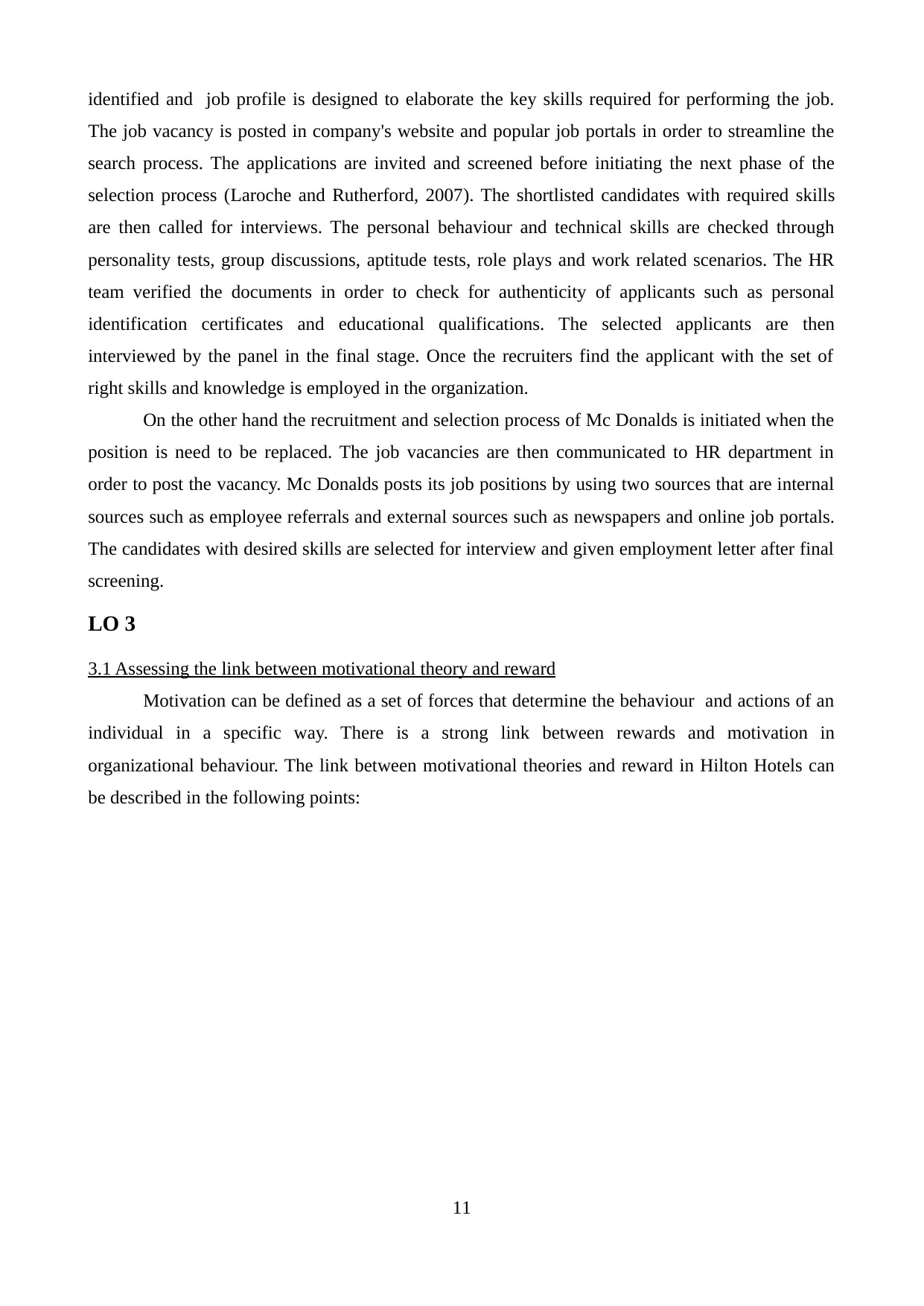
identified and job profile is designed to elaborate the key skills required for performing the job.
The job vacancy is posted in company's website and popular job portals in order to streamline the
search process. The applications are invited and screened before initiating the next phase of the
selection process (Laroche and Rutherford, 2007). The shortlisted candidates with required skills
are then called for interviews. The personal behaviour and technical skills are checked through
personality tests, group discussions, aptitude tests, role plays and work related scenarios. The HR
team verified the documents in order to check for authenticity of applicants such as personal
identification certificates and educational qualifications. The selected applicants are then
interviewed by the panel in the final stage. Once the recruiters find the applicant with the set of
right skills and knowledge is employed in the organization.
On the other hand the recruitment and selection process of Mc Donalds is initiated when the
position is need to be replaced. The job vacancies are then communicated to HR department in
order to post the vacancy. Mc Donalds posts its job positions by using two sources that are internal
sources such as employee referrals and external sources such as newspapers and online job portals.
The candidates with desired skills are selected for interview and given employment letter after final
screening.
LO 3
3.1 Assessing the link between motivational theory and reward
Motivation can be defined as a set of forces that determine the behaviour and actions of an
individual in a specific way. There is a strong link between rewards and motivation in
organizational behaviour. The link between motivational theories and reward in Hilton Hotels can
be described in the following points:
11
The job vacancy is posted in company's website and popular job portals in order to streamline the
search process. The applications are invited and screened before initiating the next phase of the
selection process (Laroche and Rutherford, 2007). The shortlisted candidates with required skills
are then called for interviews. The personal behaviour and technical skills are checked through
personality tests, group discussions, aptitude tests, role plays and work related scenarios. The HR
team verified the documents in order to check for authenticity of applicants such as personal
identification certificates and educational qualifications. The selected applicants are then
interviewed by the panel in the final stage. Once the recruiters find the applicant with the set of
right skills and knowledge is employed in the organization.
On the other hand the recruitment and selection process of Mc Donalds is initiated when the
position is need to be replaced. The job vacancies are then communicated to HR department in
order to post the vacancy. Mc Donalds posts its job positions by using two sources that are internal
sources such as employee referrals and external sources such as newspapers and online job portals.
The candidates with desired skills are selected for interview and given employment letter after final
screening.
LO 3
3.1 Assessing the link between motivational theory and reward
Motivation can be defined as a set of forces that determine the behaviour and actions of an
individual in a specific way. There is a strong link between rewards and motivation in
organizational behaviour. The link between motivational theories and reward in Hilton Hotels can
be described in the following points:
11
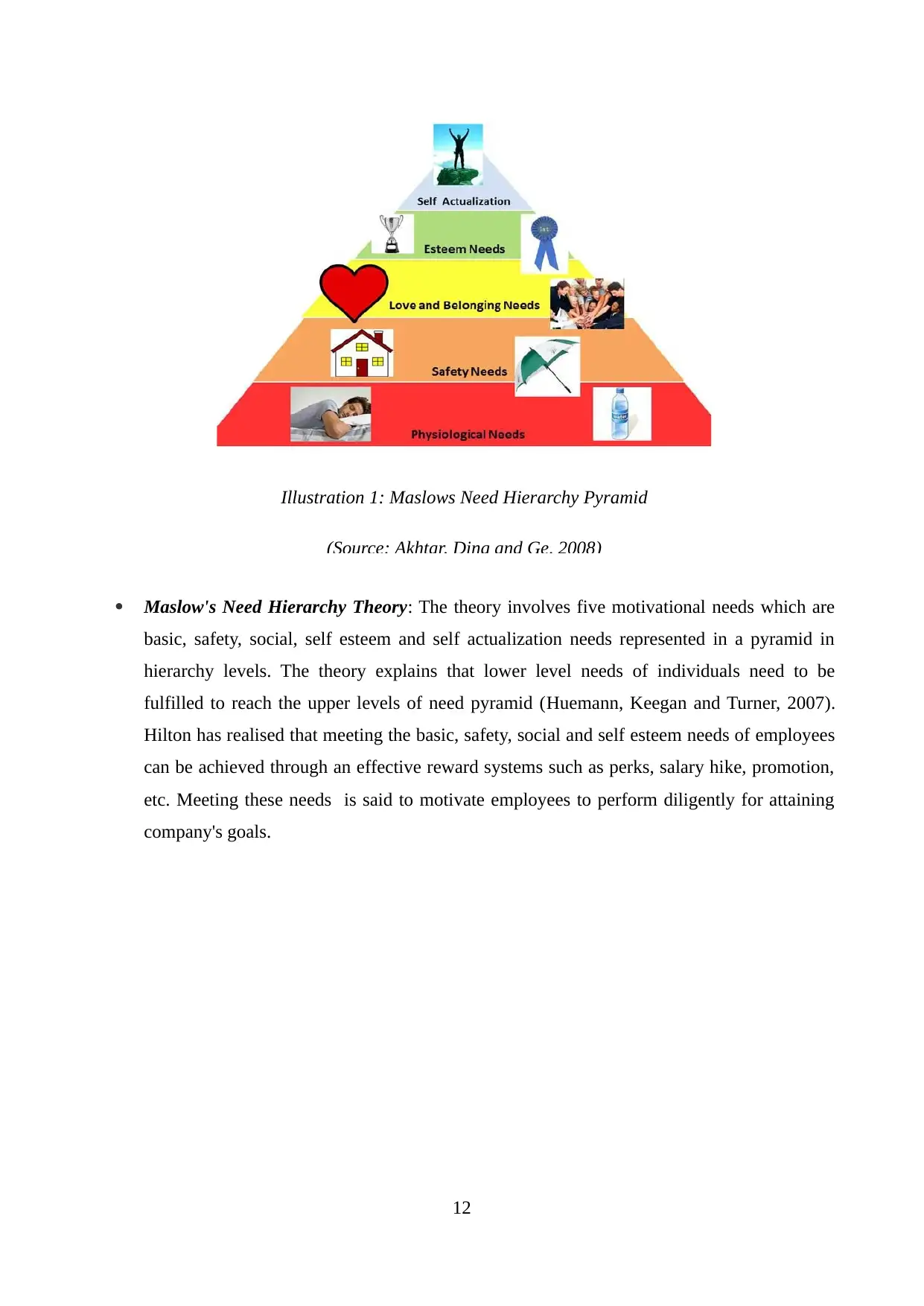
Maslow's Need Hierarchy Theory: The theory involves five motivational needs which are
basic, safety, social, self esteem and self actualization needs represented in a pyramid in
hierarchy levels. The theory explains that lower level needs of individuals need to be
fulfilled to reach the upper levels of need pyramid (Huemann, Keegan and Turner, 2007).
Hilton has realised that meeting the basic, safety, social and self esteem needs of employees
can be achieved through an effective reward systems such as perks, salary hike, promotion,
etc. Meeting these needs is said to motivate employees to perform diligently for attaining
company's goals.
12
Illustration 1: Maslows Need Hierarchy Pyramid
(Source: Akhtar, Ding and Ge, 2008)
basic, safety, social, self esteem and self actualization needs represented in a pyramid in
hierarchy levels. The theory explains that lower level needs of individuals need to be
fulfilled to reach the upper levels of need pyramid (Huemann, Keegan and Turner, 2007).
Hilton has realised that meeting the basic, safety, social and self esteem needs of employees
can be achieved through an effective reward systems such as perks, salary hike, promotion,
etc. Meeting these needs is said to motivate employees to perform diligently for attaining
company's goals.
12
Illustration 1: Maslows Need Hierarchy Pyramid
(Source: Akhtar, Ding and Ge, 2008)
⊘ This is a preview!⊘
Do you want full access?
Subscribe today to unlock all pages.

Trusted by 1+ million students worldwide
1 out of 19
Related Documents
Your All-in-One AI-Powered Toolkit for Academic Success.
+13062052269
info@desklib.com
Available 24*7 on WhatsApp / Email
![[object Object]](/_next/static/media/star-bottom.7253800d.svg)
Unlock your academic potential
Copyright © 2020–2025 A2Z Services. All Rights Reserved. Developed and managed by ZUCOL.





